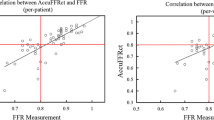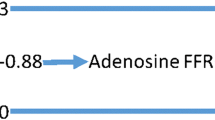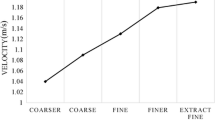Abstract
The purpose of the study was to evaluate the optimal cut-off value of CT-Fractional Flow Reserve (CT-FFR) using fluid–structure interaction and how to adjust the CT-FFR’s underestimation from a standpoint of minimize 1-year cardiac events. Subjects were 38 cases with 44 vessels in which stenosis of 30–90% was detected using one-rotation scanning by 320-row coronary CT angiography (CCTA) and invasive FFR (i-FFR) was performed within subsequent 90 days. CT-FFR was calculated using on-site from the multiple cardiac phases. A hypothetical 1-year cardiac event incidence was estimated using previous evidences when revascularization was decided based on CT-FFR. We assessed the optimal cut-off value of CT-FFR and how to correct the CT-FFR to minimize hypothetical cardiac events under four different disease prevalence (20%, 25%, 30%, 35%, and 40%). A total of 16 vessels had i-FFR ≤ 0.8. On per-patient basis, the sensitivity, specificity, positive predict value, negative predict value, and diagnostic accuracy of CT-FFR ≦ 0.8 vs CCTA > 50% to detect functional stenosis defined as invasive FFR ≦ 0.80 were 93.3% vs 73.3%, 73.9% vs 26.1%, 70.0% vs 39.3%, 94.4% vs 60.0%, and 81.6% vs 44.7%, respectively. For minimize 1-year cardiac events, the optimal cut-off value for more than 30% of disease prevalence was 0.80. However, the optimal cut-off value for 20, 25, and 30% was 0.54 in any cases. After the adjustment of CT-FFR using a formula of 0.3X + 0.634 for CT-FFR < 0.7 to counteract its underestimation, the % reduction of the events for 20, 25, 30, 35, and 40% at a 0.80 cut-off were 19.0%, 15.6%, 12.6%, 10.0%, and 7.7% respectively. It was reasonable to support that the optimal cut-off value was 0.80 in disease prevalence of more than 30% for minimize 1-year cardiac events. However, underestimation should be adjusted to reduce cardiac events, especially when disease prevalence is low.



Similar content being viewed by others
References
Koo BK, Erglis A, Doh JH, Daniels DV, Jegere S, Kim HS, Dunning A, DeFrance T, Lansky A, Leipsic J, Min JK (2011) Diagnosis of ischemia-causing coronary stenoses by noninvasive fractional flow reserve computed from coronary computed tomographic angiograms. Results from the prospective multicenter DISCOVER-FLOW (Diagnosis of ischemia-causing stenoses obtained via noninvasive fractional flow reserve) study. J Am Coll Cardiol 58(19):1989–1997
Min JK, Leipsic J, Pencina MJ, Berman DS, Koo BK, van Mieghem C, Erglis A, Lin FY, Dunning AM, Apruzzese P, Budoff MJ, Cole JH, Jaffer FA, Leon MB, Malpeso J, Mancini GB, Park SJ, Schwartz RS, Shaw LJ, Mauri L (2012) Diagnostic accuracy of fractional flow reserve from anatomic CT angiography. JAMA 308(12):1237–1245
Nørgaard BL, Leipsic J, Gaur S, Seneviratne S, Ko BS, Ito H, Jensen JM, Mauri L, De Bruyne B, Bezerra H, Osawa K, Marwan M, Naber C, Erglis A, Park S-J, Christiansen EH, Kaltoft A, Lassen JF, Bøtker HE, Achenbach S (2014) Diagnostic performance of noninvasive fractional flow reserve derived from coronary computed tomography angiography in suspected coronary artery disease. J Am Coll Cardiol 63(12):1145–1155
Wu W, Pan DR, Foin N, Pang S, Ye P, Holm N, Ren XM, Luo J, Nanjundappa A, Chen SL (2016) Noninvasive fractional flow reserve derived from coronary computed tomography angiography for identification of ischemic lesions: a systematic review and meta-analysis. Sci Rep 6:29409
Baumann S, Renker M, Hetjens S, Fuller SR, Becher T, Lossnitzer D, Lehmann R, Akin I, Borggrefe M, Lang S, Wichmann JL, Schoepf UJ (2016) Comparison of coronary computed tomography angiography-derived vs invasive fractional flow reserve assessment: meta-analysis with subgroup evaluation of intermediate stenosis. Acad Radiol 23(11):1402–1411
Cook CM, Petraco R, Shun-Shin MJ, Ahmad Y, Nijjer S, Al-Lamee R, Kikuta Y, Shiono Y, Mayet J, Francis DP, Sen S, Davies JE (2017) Diagnostic accuracy of computed tomography-derived fractional flow reserve: a systematic review. JAMA Cardiol 2(7):803–810
Douglas PS, Pontone G, Hlatky MA, Patel MR, Norgaard BL, Byrne RA, Curzen N, Purcell I, Gutberlet M, Rioufol G, Hink U, Schuchlenz HW, Feuchtner G, Gilard M, Andreini D, Jensen JM, Hadamitzky M, Chiswell K, Cyr D, Wilk A, Wang F, Rogers C, De Bruyne B, Investigators P (2015) Clinical outcomes of fractional flow reserve by computed tomographic angiography-guided diagnostic strategies vs. usual care in patients with suspected coronary artery disease: the prospective longitudinal trial of FFR(CT): outcome and resource impacts study. Eur Heart J 36(47):3359–3367
Hlatky MA, De Bruyne B, Pontone G, Patel MR, Norgaard BL, Byrne RA, Curzen N, Purcell I, Gutberlet M, Rioufol G, Hink U, Schuchlenz HW, Feuchtner G, Gilard M, Andreini D, Jensen JM, Hadamitzky M, Wilk A, Wang F, Rogers C, Douglas PS, Investigators P (2015) Quality-of-life and economic outcomes of assessing fractional flow reserve with computed tomography angiography: PLATFORM. J Am Coll Cardiol 66(21):2315–2323
Hirohata K, Kano A, Goryu A, Ooga J, Hongo T, Higashi S, Fujisawa Y, Wakai S, Arakita K, Ikeda Y, Kaminaga S, Ko B (2015) A novel CT-FFR method for the coronary artery based on 4D-CT image analysis and structural and fluid analysis. SPIE Med Imaging. https://doi.org/10.1117/12.2081674
Kato M, Hirohata K, Kano A, Higashi S, Goryu A, Hongo T, Kaminaga S, Fujisawa Y (2015) Fast CT-FFR analysis method for the coronary artery based on 4D-CT image analysis and structural and fluid analysis. In: Proceedings of the American Society of Mechanical Engineers 2015 international mechanical engineering congress and exposition. ASME, New York. doi: 10.1115/IMECE2015-51124
Fujimoto S, Kawasaki T, Kumamaru KK, Kawaguchi Y, Dohi T, Okonogi T, Ri K, Yamada S, Takamura K, Kato E, Kato Y, Hiki M, Okazaki S, Aoki S, Mitsouras D, Rybicki FJ, Daida H (2019) Diagnostic performance of on-site computed CT-fractional flow reserve based on fluid–structure interactions: comparison with invasive fractional flow reserve and instantaneous wave-free ratio. Eur Heart J Cardiovasc Imaging 20(3):343–352
Ko BS, Cameron JD, Munnur RK, Wong DTL, Fujisawa Y, Sakaguchi T, Hirohata K, Hislop-Jambrich J, Fujimoto S, Takamura K, Crossett M, Leung M, Kuganesan A, Malaiapan Y, Nasis A, Troupis J, Meredith IT, Seneviratne SK (2017) Noninvasive CT-Derived FFR based on structural and fluid analysis: a comparison with invasive FFR for detection of functionally significant stenosis. JACC Cardiovasc Imaging 10(6):663–673
Agatston AS, Janowitz WR, Hildner FJ, Zusmer NR, Viamonte M Jr, Detrano R (1990) Quantification of coronary artery calcium using ultrafast computed tomography. J Am Coll Cardiol 15(4):827–832
Kato E, Fujimoto S, Takamura K, Kawaguchi Y, Aoshima C, Hiki M, Kumamaru KK, Daida H (2018) Clinical significance of transluminal attenuation gradient in 320-row area detector coronary CT angiography. Heart Vessels 33(5):462–469
Rybicki FJ, Otero HJ, Steigner ML, Vorobiof G, Nallamshetty L, Mitsouras D, Ersoy H, Mather RT, Judy PF, Cai T, Coyner K, Schultz K, Whitmore AG, Di Carli MF (2008) Initial evaluation of coronary images from 320-detector row computed tomography. Int J Cardiovasc Imaging 24(5):535–546
Gosling O, Loader R, Venables P, Rowles N, Morgan-Hughes G, Roobottom C (2010) Cardiac CT: are we underestimating the dose? A radiation dose study utilizing the 2007 ICRP tissue weighting factors and a cardiac specific scan volume. Clin Radiol 65(12):1013–1017
Kawaguchi YO, Fujimoto S, Kumamaru KK, Kato E, Dohi T, Takamura K, Aoshima C, Kamo Y, Kato Y, Hiki M, Okai I, Okazaki S, Aoki S, Daida H (2019) The predictive factors affecting false positive in on-site operated CT-fractional flow reserve based on fluid and structural interaction. Int J Cardiol Heart Vasc. https://doi.org/10.1016/j.ijcha.2019.100372
Kimura T, Shiomi H, Kuribayashi S, Isshiki T, Kanazawa S, Ito H, Ikeda S, Forrest B, Zarins CK, Hlatky MA, Norgaard BL (2015) Cost analysis of non-invasive fractional flow reserve derived from coronary computed tomographic angiography in Japan. Cardiovasc Interv Ther 30(1):38–44
Pijls NH, van Schaardenburgh P, Manoharan G, Boersma E, Bech JW, van't Veer M, Bar F, Hoorntje J, Koolen J, Wijns W, de Bruyne B (2007) Percutaneous coronary intervention of functionally nonsignificant stenosis: 5-year follow-up of the DEFER Study. J Am Coll Cardiol 49(21):2105–2111
Tonino PA, De Bruyne B, Pijls NH, Siebert U, Ikeno F, van' t Veer M, Klauss V, Manoharan G, Engstrom T, Oldroyd KG, Ver Lee PN, MacCarthy PA, Fearon WF, Investigators FS (2009) Fractional flow reserve versus angiography for guiding percutaneous coronary intervention. N Engl J Med 360(3):213–224
Tonino PA, Fearon WF, De Bruyne B, Oldroyd KG, Leesar MA, Ver Lee PN, Maccarthy PA, Van't Veer M, Pijls NH (2010) Angiographic versus functional severity of coronary artery stenoses in the FAME study fractional flow reserve versus angiography in multivessel evaluation. J Am Coll Cardiol 55(25):2816–2821
Stone GW, Maehara A, Lansky AJ, de Bruyne B, Cristea E, Mintz GS, Mehran R, McPherson J, Farhat N, Marso SP, Parise H, Templin B, White R, Zhang Z, Serruys PW, Investigators P (2011) A prospective natural-history study of coronary atherosclerosis. N Engl J Med 364(3):226–235
Ri K, Kumamaru KK, Fujimoto S, Kawaguchi Y, Dohi T, Yamada S, Takamura K, Kogure Y, Yamada N, Kato E, Irie R, Takamura T, Suzuki M, Hori M, Aoki S, Daida H (2018) Noninvasive computed tomography-derived fractional flow reserve based on structural and fluid analysis: reproducibility of on-site determination by unexperienced observers. J Comput Assist Tomogr 42(2):256–262
Acknowledgements
Dr. Shigeki Aoki has received speakers’ Bureau/Honoraria from Canon Medical Systems Corporation that is related to this study. He has also received a research funds from Daiichi-Sankyo Company, Medi-Physics Co., FUJIFILM Toyama Chemical Co. and Bayer Holding Ltd. and speakers’ Bureau/Honoraria from Bayer Holding Ltd., Daiichi-Sankyo Company, FUJIFILM Toyama Chemical Co. and Medi-Physics Co. that are not related to this study. Dr. Hiroyuki Daida has received a research funds and speakers’ Bureau/Honoraria from Canon Medical Systems Corporation that is related to this study. He has also received research funds from Daiichi-Sankyo Company and Medi-Physics Co. and speakers’ Bureau/Honoraria from FUJIFILM Toyama Chemical Co. and Daiichi-Sankyo Company that are not related to this study. Dr. Shinichiro Fujimoto and Dr. Kanako K. Kumamaru have received speakers’ Bureau/Honoraria from Canon Medical Systems Corporation that is related to this study.
Author information
Authors and Affiliations
Corresponding author
Ethics declarations
Conflict of interest
All other authors have no potential conflict of interest.
Additional information
Publisher's Note
Springer Nature remains neutral with regard to jurisdictional claims in published maps and institutional affiliations.
Rights and permissions
About this article
Cite this article
Kato, E., Fujimoto, S., Kumamaru, K.K. et al. Adjustment of CT-fractional flow reserve based on fluid–structure interaction underestimation to minimize 1-year cardiac events. Heart Vessels 35, 162–169 (2020). https://doi.org/10.1007/s00380-019-01480-4
Received:
Accepted:
Published:
Issue Date:
DOI: https://doi.org/10.1007/s00380-019-01480-4




